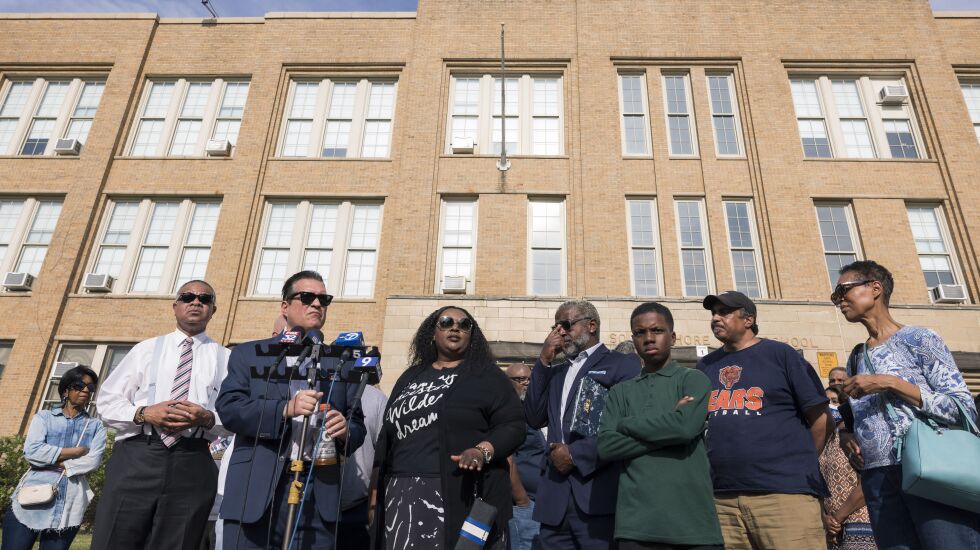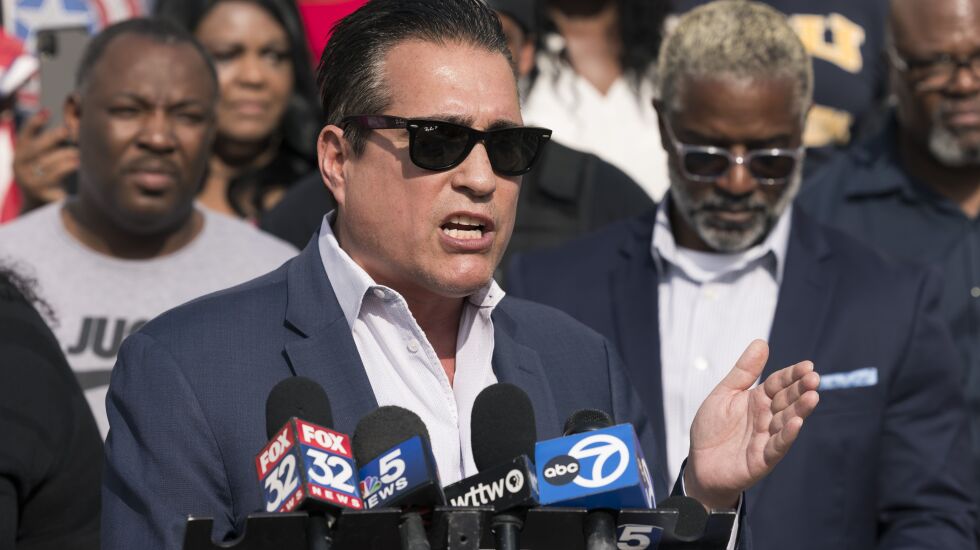
South Shore residents filed a lawsuit hoping to stop a former high school from being turned into a temporary shelter for asylum-seekers, alleging among other things that the plan violates the city’s lease agreement with the building.
The lawsuit was filed Wednesday in Cook County circuit court and names the city and Chicago Public Schools as defendants. It seeks a temporary emergency restraining order against the plan.
“We were forced to do this, we had to do this,” said Natasha Dunn, one of the residents named as a petitioner in the lawsuit, at a news conference Thursday surrounded by neighbors outside shuttered South Shore High School at 7627 S. Constance Ave.
“This is not about the migrants, this is about the entire city of Chicago ignoring our community, because this school belongs to us,” Dunn said, adding that the city didn’t include neighbors in conversations about the plan to house asylum-seekers at the school.
The lawsuit states that in March 2019 the City Council passed an ordinance establishing a lease agreement between the city as tenant and the Board of Education of the City of Chicago as landlord. The lease authorized the city’s use of the former school for the Chicago police and fire departments.

“The purpose of this lease was to allocate the building specifically for the use of these departments. Therefore, any action that deviates from this intended purpose, such as transforming the building into a refugee shelter, would be in violation of the lease agreement,” the suit states.
Mayor Lori Lightfoot’s office was criticized by Woodlawn residents earlier this year when a shuttered school was converted into a shelter for immigrants. And now residents in neighboring South Shore are expressing similar frustrations.
Frank Avila, the attorney representing the residents, said the plan also violates zoning ordinances around the school.
“This is not zoned for residential housing,” Avila said. “If one of the groups here said we wanted to house at-risk kids, we want to house homeless people, they would be stopped.”
City officials have said the school would serve as a respite shelter for 250 to 500 migrants at a time until more permanent housing is found for them.
The suit is the latest move by concerned residents who hope to keep asylum-seekers from being housed in the neighborhood, saying the resources being spent to help the migrants should instead be used to tackle issues of inequality in the area.
“We’re talking about an underfunded community with closed schools, with closed programs, with closed social services, housing issues and the like,” Avila said. “There are social services that are needed for low-income residents, whatever their race. None of these resources have been made available.”
Dunn said “we expect the city, the state and everyone to provide us humanitarian aid,” and wants an office of Black Americans created in city government to help residents tackle their issues.
The lawsuit also alleges that housing asylum-seekers in the school would be unsafe not just for residents, but for the migrants being sheltered.
It states that though authorities have established rules and regulations for the migrants who will stay at the school, “no provisions have been established regarding expectations for their conduct within the surrounding residential area. This lack of clarity poses a potential threat to the safety, property and overall well-being” of the residents.
Avila said housing the migrants in neighborhoods that have high levels of crime could have adverse effects on their mental health, and they should be placed in safer areas.
“If we’re talking about migrants and asylum-seekers that came from violent nations, that came from war, that came from poverty, why are we putting them in an area where they could be further traumatized, in high-crime areas? Avila said. “You’re putting them in areas where there is a different culture, a different language and they also are in an area of high crime, so we’re further traumatizing them, those who may have PTSD or other issues.”
Additionally, the suit alleges that though police have said they will have round-the-clock presence at the location, residents have experienced slow response times — ranging from four to six hours — for incidents in the neighborhood. “This contradiction raises concerns about the ability of authorities to fulfill their assurances,” the suit states.
Residents have said they wanted the building turned over to the community so it can serve as a hub for youth, offering art classes, courses on entrepreneurship, environmentalism and more.
A community meeting on the plan last week turned chaotic after angry residents refused to hear the city’s presentation on the shelter and shouted down officials.
“The city does not comment on ongoing litigation,” the law department said.
Avila said a hearing on the suit was scheduled for Friday.







